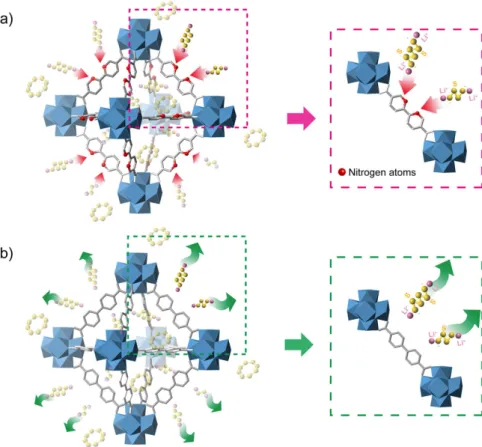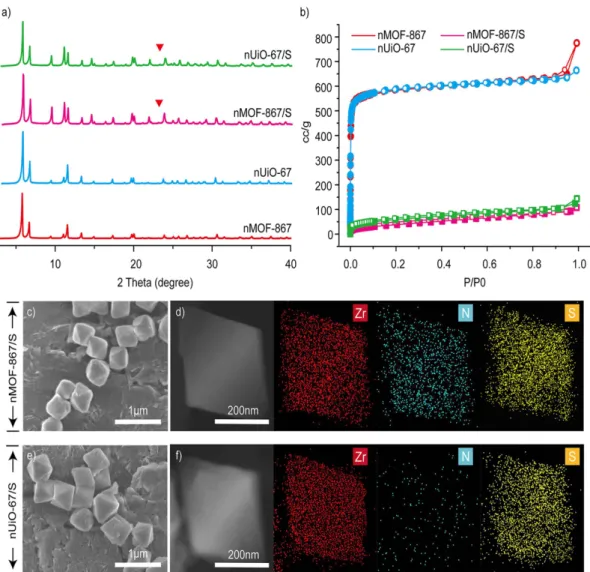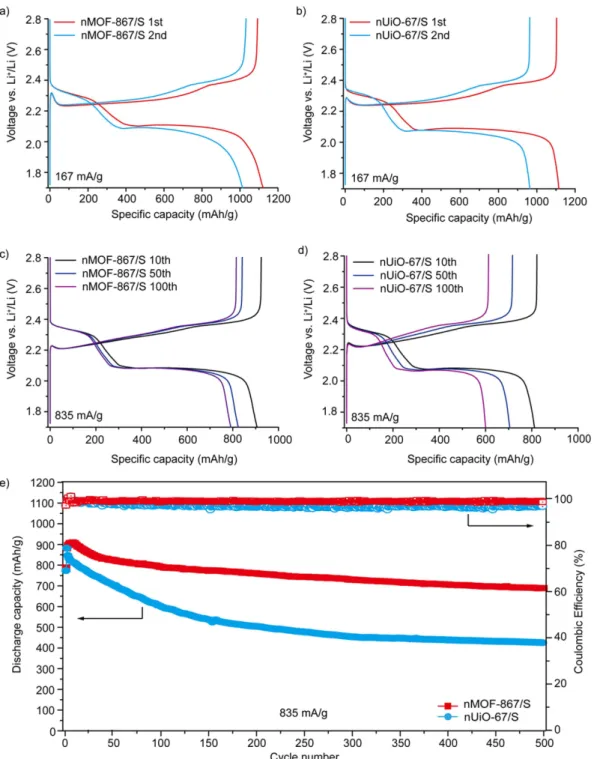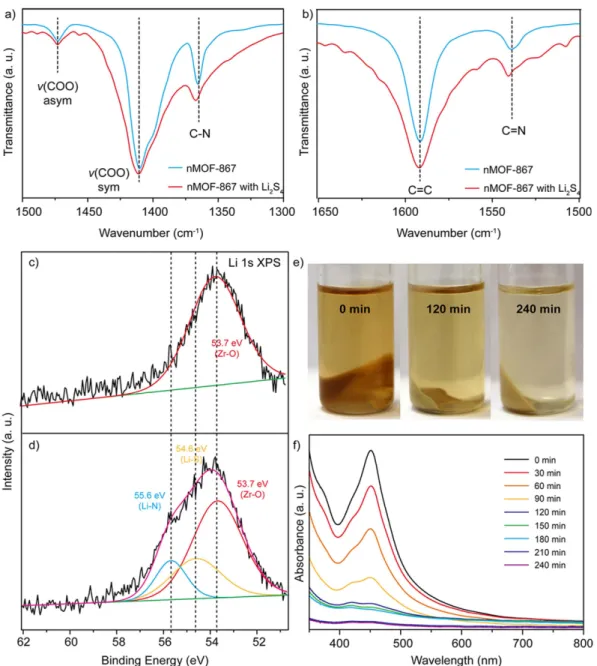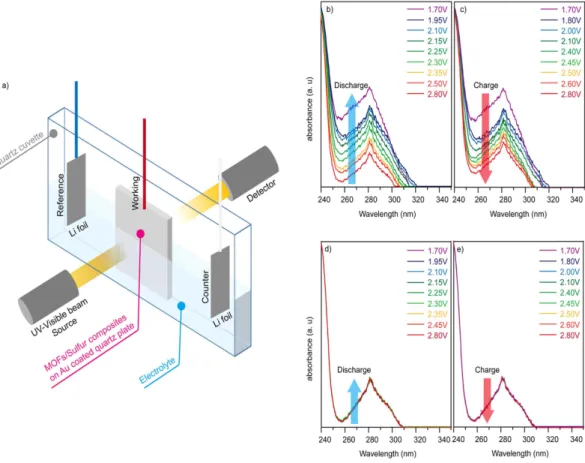www.nature.com/scientificreports
Encapsulation of redox
polysulphides via chemical
interaction with nitrogen atoms in
the organic linkers of metal-organic
framework nanocrystals
Jung Hyo Park
1,*, Kyung Min Choi
1,2,*, Dong Ki Lee
1, Byeong Cheul Moon
3, Sang Rim Shin
1,
Min-Kyu Song
4& Jeung Ku Kang
1,3Lithium polysulphides generated during discharge in the cathode of a lithium-sulphur redox cell are important, but their dissolution into the electrolyte from the cathode during each redox cycle leads to a shortened cycle life. Herein, we use in situ spectroelectrochemical measurements to demonstrate that sp2 nitrogen atoms in the organic linkers of nanocrystalline metal-organic framework-867
(nMOF-867) are able to encapsulate lithium polysulphides inside the microcages of nMOF-867, thus helping to prevent their dissolution into the electrolyte during discharge/charge cycles. This encapsulation mechanism of lithiated/delithiated polysulphides was further confirmed by observations of shifted FTIR spectra for the C = N and C-N bonds, the XPS spectra for the Li-N bonds from nMOF-867, and a visualization method, demonstrating that nMOF-867 prevents lithium polysulphides from being dissolved in the electrolyte. Indeed, a cathode fabricated using nMOF-867 exhibited excellent capacity retention over a long cycle life of 500 discharge/charge cycles, with a capacity loss of approximately 0.027% per cycle from a discharge capacity of 788 mAh/g at a high current rate of 835 mA/g.
The most critical challenge in energy storage is the development of high-performance energy storage devices that combine a stable cycle life with a high energy density1–6. The lithium-sulphur (Li-S) redox cell, which has a high
theoretical energy density, may be a good system that can overcome this challenge7,8. In addition, sulphur is safe,
inexpensive and abundant on Earth9,10. Unfortunately, the high-order polysulphides formed by reactions between
cyclic octasulphur (S8) and lithium ions during the discharge reactions are soluble in most organic electrolyte
solutions11,12, thus leading to quickly fading capacities during discharge/charge redox cycles. Moreover, the
lith-ium polysulphides can move to the lithlith-ium anode electrode and form insoluble Li2S2 and/or Li2S species on its
surface13,14. Furthermore, the lithium polysulphides can diffuse back and forth between the cathode and anode
electrodes, in a phenomenon known as the shuttle effect, thus decreasing the cycle life of Li-S redox cells15,16.
Therefore, a new paradigm structure or mechanism that can effectively prevent the dissolution of polysulphides to provide excellent capacity retention over long discharge/charge redox cycles would represent a major break-through in the realization of high-performance energy storage.
In principle, the functional heteroatoms embedded in the organic linkers in metal-organic frameworks (MOFs)17–19 can be used to create specific interactions with the lithium polysulphides20,21. Therefore, we
hypoth-esized that the sp2 nitrogen in the linkers of the microcages of nanosized MOF-86722 (Zr
6O4(OH)4(BPYDC)6, 1Department of Materials Science and Engineering, Advanced Institute of Science and Technology Korea 291 Daehak-ro, Yuseong-gu, Daejeon 34141, Republic of Korea. 2Department of Chemical and Biological Engineering, Sookmyung Women’s University Cheonpa-ro 47-gil 100, Yongsan-gu, Seoul 04310, Republic of Korea. 3Graduate School of EEWS (Energy, Environment, Water, and Sustainability) Korea Advanced Institute of Science and Technology 291 Daehak-ro, Yuseong-gu, Daejeon 34141, Republic of Korea. 4School of Mechanical and Materials Engineering, Washington State University Pullman, Washington 99164-2920, USA. *These authors contributed equally to this work. Correspondence and requests for materials should be addressed to M.K.S. (email: minkyu. song@wsu.edu) or J.K.K. (email: jeung@kaist.ac.kr)
Received: 08 January 2016 accepted: 18 April 2016 Published: 05 May 2016
OPEN
BPYDC = 2,2′ -bipyridine-5,5′ -dicarboxylate, abbreviated as nMOF-867) could be combined with the lithium polysulphides to prevent their dissolution into the electrolyte, as shown in Fig. 1. This combination would allow full redox reactions with sulphur over an extended cycle life. For comparison, we also prepared another nano-sized MOF with no sp2 nitrogens in its organic linker (Zr
6O4(OH)4(BPDC)6, BPDC = 4,4′ -biphenyldicarboxylate,
termed nUiO-67)23 but with the same crystal structure as nMOF-867. We found that the high-order
polysul-phides from the lithiation of the S8 species could be encapsulated inside the microcages of nMOF-867, thus
preventing lithium polysulphide dissolution and extending the cycle life. To confirm the self-encapsulation of polysulphides in the microcages, we used a combination of experimental characterizations including in situ spec-troelectrochemical measurements, FTIR spectroscopy to identify C = N and C-N bonds, XPS spectroscopy to determine the existence of Li-N bond orbitals during discharge, and a visualization method. This is the first direct demonstration confirming the mechanism and interaction of lithium polysulphide with functional heteroatoms in the organic linkers of MOFs.
Results and Discussion
nMOF-867 was prepared by dissolving zirconium chloride (ZrCl4) and H2BPYDC in N,N-dimethylformamide
(DMF) in a 20 mL glass vial at room temperature. The sp2 nitrogen in BPYDC exists as a heteroatom replacing
the = CH- group in the aromatic ring. Then, acetic acid and triethylamine (TEA) were added to the stock solu-tion, which was sonicated for 20 min. The glass vial was placed into an oven at 85 °C for 12 hrs to grow the nano-crystalline MOFs. For nUiO-67, a H2BPDC organic linker was used in place of H2BPYDC in nMOF-867, and all
of the other ingredients as well as the heating process were the same as those used for nMOF-867 (Figure S1). The products were washed with DMF several times and immersed in methanol for three days. Next, the products were activated in a vacuum oven at 100 °C for 24 hrs. Then, the activated nMOFs were mixed with high-purity sulphur in a mortar in an Ar-filled glove box, and the mixtures were placed in a sealed vessel. The vessel was heated to 155 °C for 12 hrs in a tubular quartz furnace with flowing Ar. The viscosity of sulphur was lowest at 155 °C, and the molten sulphur was found to be infused into the microcages of nMOFs. The sulphur-infiltrated nMOF-867 and nUiO-67 (abbreviated as nMOF-867/S and nUiO-67/S, respectively) were maintained in an Ar-filled glove box to avoid moisture uptake from the atmosphere.
The structures were characterized by powder X-ray diffraction (PXRD), nitrogen gas adsorption isotherm measurements, scanning electron microscopy (SEM), scanning transmission electron microscopy (STEM), energy dispersive X-ray spectroscopy (EDS) and thermal gravimetric analysis (TGA). The PXRD patterns for nMOF-867 and nUiO-67 contained sharp diffraction peaks at defined positions that were in agreement with simulated patterns24,25, indicating that the samples possessed high crystallinity, and their underlying crystal
Figure 1. Schematic illustration of the chemical interactions between nitrogen atoms and lithium
polysulphides. (a) The sp2 nitrogen atoms and lithium polysulphides interact chemically in nMOF-867. (b) The
www.nature.com/scientificreports/
structures were the same (Fig. 2a). The type I nitrogen gas adsorption isotherm (Fig. 2b) indicated that the per-manent porosity and high BET surface areas (2250 m2/g for nMOF-867 and 2256 m2/g for nUiO-67) provided
sufficient space for retaining the sulphur. The octahedral morphologies of nMOF-867 and nUiO-67 that were ca. 500 nm in diameter were also determined through SEM measurements (Figure S2). Notably, the fabrication of nMOF-867 and nUiO-67 particles that are homogeneous in size and morphology can eliminate the issues related to the transport properties of sulphur, lithium ions, and electrons26.
Before the infiltration of sulphur into the nMOFs, nMOF-867 and nUiO-67 were mixed with sulphur with-out a heating process. The measured PXRD patterns, which are shown in Figures S3 and S4, contained the main peak for pure sulphur at approximately 23° as well as the sharp peaks for nMOFs. In addition, the PXRD pat-terns after the heating process at 155 °C (Fig. 2a) demonstrated that nMOF-867/S and nUiO-67/S retained their crystal structures. However, the main peak for pure sulphur (indicated as the red triangle in the PXRD patterns shown in Fig. 2a) disappeared after the heating process because the sulphur particles were well absorbed into the microcages of the nMOF-867 and nUiO-67 particles27. In addition, after sulphur infiltration, the specific surface
areas of nMOF-867/S and nUiO-67/S substantially decreased to 147 and 150 m2/g, respectively (Fig. 2b). In
com-bination with the PXRD patterns, this evidence indicates that these surface area reductions did not result from structural collapse but were due to the infiltration of sulphur into the microcages of nMOF-867 and nUiO-67. The SEM images shown in Fig. 2c,e further indicated that both the crystal size and shape of nMOF-867/S and nUiO-67/S were well maintained after sulphur infiltration. Moreover, the STEM and EDS mapping (Fig. 2d,f) of nMOF-867/S and nUiO-67/S indicated that sulphur had infiltrated into both MOFs after the heating process. The nitrogen signal was detected only in nMOF-867/S because its organic linkers (BPYDC) contain sp2 nitrogen
atoms. Moreover, the TGA measurements (Figures S5 and S6) of nMOF-867 and nUiO-67 demonstrated their identically high thermal stability up to 400 °C.
Figure 2. Structural analysis of pristine nMOF and nMOF/sulphur composites using PXRD, nitrogen gas adsorption, and STEM and EDS mapping. (a) The PXRD patterns of pristine nMOF-867, pristine nUiO-67,
867/S and nUiO-67/S. (b) Nitrogen gas adsorption of pristine 867, pristine nUiO-67, nMOF-867/S and nUiO-67/S. (c,e) SEM images of nMOF-nMOF-867/S and nUiO-67/S. (d,f) EDS mapping of nMOF-867 and nUiO-67/S, respectively.
We also explored the electrochemical performance of the Li-S redox system with nMOFs/S. First, the nMOFs/S was mixed with conductive super P and polyvinylidene fluoride (PVDF) binder in N-methyl-2-pyrrolidinone (NMP), which resulted in the formation of a viscous slurry that was coated on aluminium foil and dried under vacuum at 60 °C for 24 hrs. Next, 2032-type cells were assembled with lithium foil as the coun-ter electrode in an Ar-filled glove box. The electrolyte consisted of 1 M lithium bis(trifluoromethanesulphonyl) imide (LiTFSI) in N-methyl-N-butylpyrrolidinium bis(trifluoromethane sulphonyl)imide (PYR14TFSI)/1, 2-dimethoxyethane/1,3-dioxolane (2:1:1 by volume) with LiNO3 (1 wt%) as an additive to help passivate the
sur-face of the lithium anode and prevent the shuttle effect28,29.
The typical discharge/charge profiles of the nMOF-867/S composites are shown in Fig. 3a. Initially, a constant current of 167 mA/g, corresponding to 0.1 C, was used to study discharge/charge behaviours for nMOF-867 over
Figure 3. Electrochemical performance of nMOF-867/S and nUiO-67/S. (a) 1st and 2nd discharge/charge
profiles of nMOF-867/S (at 167 mA/g). (b) 1st and 2nd discharge/charge profiles of nUiO-67/S (at 167 mA/g).
(c) 10th, 50th and 100th discharge/charge profiles of nMOF-867/S (at 835 mA/g). (d) 10th, 50th and 100th
discharge/charge profiles of nUiO-67/S (at 835 mA/g). (e) Long-term cycle performance over 500 cycles for nMOF-867/S and nUiO-67/S with a constant current of 835 mA/g.
www.nature.com/scientificreports/
a voltage range of 1.7 to 2.8 V. Two plateaus were observed at approximately 2.3 and 2.1 V in the discharge pro-cess. The plateau at approximately 2.3 V was related to the reduction of S8 to long-chain lithium polysulphides
(Li2Sn, 4 ≤ n ≤ 8), and the plateau at approximately 2.1 V corresponded to the formation of short-chain lithium
polysulphides, such as Li2S2 and Li2S30,31. The initial discharge capacity of nMOF-867/S was 1121 mAh/g. For
nUiO-67/S, the initial discharge behaviour and capacity (1115 mAh/g at 167 mA/g) were very similar to those of nMOF-867/S (Fig. 3b). Figure S7 also shows the first few discharge/charge profiles of nMOFs/S, in which the profiles for the 4th to 8th cycles were similar to those of the 1st and 2nd cycles. This result indicated that the N atoms
covalently bound to C atoms in the organic linkers of the nanocrystalline MOFs formed secondary interactions with lithium polysulphides. In addition, nMOF-867/S (Fig. 3c) exhibited capacities of 906, 824 and 790 mAh/g for the 10th, 50th and 100th discharge capacities, respectively, at a high current rate of 835 mA/g. However,
nUiO-67/S (Fig. 3d) exhibited capacities of 811, 704 and 600 mAh/g, respectively. Even after a long cycle life with more than 500 discharge/charge cycles, nMOF-867/S exhibited stable capacity retention with an average capacity loss of approximately 0.027% per cycle. Furthermore, our calculation for the number of N involved in nMOF-867 indi-cated that each nitrogen would form secondary interactions with multiple Li2S species when S8 was completely
converted to 8 Li2S.
The nitrogen forms a strong covalent bond to carbon in the organic linkers (BPYDC, chemical for-mula = C12H6N2O4) of the MOF. Indeed, the results in Fig. 3c,e indicated that the electrochemical behaviour
of MOF-867 was very stable over long cycles, thus implying that the BPYDC linkers in nMOF-867 were not destroyed but maintained the sp2 nitrogen in their aromatic rings over repeated discharge/charge cycles. Notably,
excellent performance with a specific energy density of ~1700 Wh/g over 500 cycles at a high current rate of 835 mA/g was observed. Moreover, the capacity retention behaviours of nMOF-867 were maintained at high areal loadings of active materials up to 5 mg/cm2 (Figure S8). nMOF-867 with sp2 nitrogen atoms in its organic linkers
provided stable capacity retention along with an excellent coulombic efficiency over a long discharge/charge cycle life for Li-S batteries. Therefore, the simple introduction of heterogeneous atoms into the organic linkers in the microcages of MOFs leads to stable energy performance with a high capacity retention over a long cycle life.
Additionally, we tested another set of Zn-based IRMOF-10s (ZnO4(BPDC)3 and ZnO4(BPYDC)3), which were
separately prepared with BPDC, which has no sp2 nitrogens, and BPYDC, which has sp2 nitrogens in its linker32,33.
The measured electrochemical performance (Figure S9) indicated that the capacity retention for the IRMOF-10 with the sp2 nitrogens (i.e., 64%) was much higher than for the IRMOF-10 with no sp2 nitrogens (i.e., 27%). These
results confirmed that the sp2 nitrogen in the linker of the MOF structure enhanced the capacity retention over
repeated discharge/charge cycles. Therefore, these results demonstrate that the simple introduction of heteroge-neous atoms into the organic linkers in the microcages of MOFs can lead to excellent energy storage performance, thus opening a new route for providing an excellent solution for current energy storage issues.
We further investigated the discharge/charge behaviour by using Fourier transform infrared (FTIR) spectros-copy and X-ray photoelectron spectrosspectros-copy (XPS), and these results provided detailed information regarding the chemical binding of sp2 nitrogen atoms with polysulphides. Moreover, a visual verification method was used to
directly observe the interactions between sp2 nitrogen atoms and polysulphides in the electrolyte. In addition,
spectroelectrochemical measurements were performed with in situ observation of the chemical interactions dur-ing the discharge/charge processes. To identify the interaction, we prepared a polysulphide species (Li2S4), which
was synthesized by mixing stoichiometric amounts of Li2S and sulphur in tetraethylene glycol dimethyl ether
(TEGDME)34. Then, nMOF-867 and nUiO-67 were directly mixed with the polysulphide (Li
2S4) solution. Finally,
the products were washed with methanol to remove excess polysulphide molecules, and this was followed by drying in a vacuum oven at 60 °C for 24 hrs.
The FTIR spectra of nMOF-867 and nMOF-867/Li2S4 are shown in Figure S10, and partial ranges of the
spectra are shown in Fig. 4a,b. The double bond stretching of C = C (1591 cm−1), the asymmetric and
symmet-ric stretching modes of the carboxylate (-COO-, 1473 and 1410 cm−1), and the single bond stretching of C-O
(1245 cm−1) and C-C (1163 cm−1) (Figure S11) indicated that the spectra of both samples did not change after
interaction with Li2S435. However, Fig. 4a,b show that the peaks related to atomic nitrogen (N sp2 orbitals) shifted
from 1537 to 1541 cm−1 for the C = N double bonds and 1364 to 1367 cm−1 for the C-N single bond because the
polysulphides undergo chemical interactions with the sp2 nitrogen atoms, which shift its stretching frequency.
Moreover, to obtain more detail on the chemical binding of the nitrogen sp2 orbitals during lithiation, we also
determined the XPS spectra (Fig. 4c,d) of pristine nMOF-867 and nMOF-867/Li2S4. The XPS spectrum of
nMOF-867 in the absence of Li2S4 (Fig. 4c) was fitted to a single peak that corresponded to a Zr-O binding energy of
53.7 eV36. After chemical binding of nMOF-867 with Li
2S4, the XPS spectra were deconvoluted into three peaks
corresponding to Zr-O (53.7 eV), Li-N (55.6 eV) and Li-S (54.6 eV). Figure 4d37, which indicate that the lone pair
of electrons in the sp2 nitrogen orbitals interacted with the Li in Li 2S4.
Additionally, we developed a visualization method by mixing nMOF-867 and nUiO-67 with a 0.1 M Li2S4
TEGDME solution for up to 240 min. Because Li2S4 in solution is yellow, we were able to visualize the migration
of Li2S4 by following the colour change. The photos show the colour changes of the Li2S4 solution after mixing
with both MOFs at regular intervals of 0 min, 120 min and 240 min. The results in Fig. 4e indicate that the Li2S4
solution became transparent as Li2S4 was captured by MOF-867, and the nUiO-67 in the Li2S4 solution
main-tained its yellow colour even after 240 min (Figure S12a). These results were quantified through UV-Vis spectro-scopic analysis of the Li2S4 solution after sedimentation of nMOFs every 30 min. The results demonstrated that
the Li2S4 solutions that were mixed with both nMOFs initially exhibited high absorbance intensities in the
wave-length range of 400 to 500 nm. As time progressed, the absorbance of the Li2S4 solutions mixed with nMOF-867
decreased substantially as the Li2S4 was encapsulated into nMOF-867 (Fig. 4f). However, the effect observed for
nUiO-67 was much smaller (Figure S12b). These results imply that the sp2 nitrogen atoms in the organic linkers
of nMOF-867 can encapsulate Li2S4 via chemical interactions, which prevent the dissolution of polysulphide into
the colour change. Initially, only nMOF-867 was placed in the TEGDME solvent in the absence of lithium poly-sulphides and stirred for 240 min. No colour change was observed after stirring for 240 min. Next, another glass vial was prepared containing only 0.1 M Li2S4 (lithium polysulphides) in the TEGDME solution. The initial colour
of Li2S4 was yellow, and this colour was maintained after stirring for 240 min. These results provide clear evidence
that the colour change was due to chemical interactions between sp2 nitrogens and lithium polysulphides and not
to photooxidation.
In addition, an in situ spectroelectrochemical method using a UV-visible instrument (DH-2000, Ocean Optics) linked to a potentiostat (SP-300, Bio-Logic) was developed. The cell system (Fig. 5a) was equipped with Li metal as the counter/reference electrode, and nMOFs/sulphur was deposited on Au-coated quartz plates as the working electrode. The Au-coated quartz plates were irradiated with UV and visible light to record the cyclic voltammetry (CV) data. We used quartz plates that barely absorb UV light and coated them with a thin film of Au to improve the conductivity. The UV-visible spectra of nMOF-867/S and nUiO-67/S were obtained at different voltage points on their CV profiles (Figures S14 and S15). Absorption peaks in the UV-Vis region (Fig. 5) were observed in both nMOF-867/S and nUiO-67/S during the discharge and charge cycles. The absorption intensi-ties of nMOF-867/S (Fig. 5b) increased during the discharge reactions and returned to their original intensiintensi-ties during the charge reactions (Fig. 5c). The absorption intensities of nUiO-67/S remained unchanged (Fig. 5d,e). From these results along with those from the FTIR, XPS, and visualization verification analyses, we conclude that
Figure 4. Investigation of the chemical interaction between the nitrogen atoms and the polysulphides. (a,b) FTIR spectra of pristine nMOF-867 and nMOF-867 with Li2S4. (c) XPS spectrum of pristine nMOF-867.
(d) XPS spectrum of nMOF-867/Li2S4. (e) Photos show the colour changes of nMOF-867/Li2S4 over 240 min.
www.nature.com/scientificreports/
polysulphides are generated and encapsulated in the microcages of nMOF-867, which exhibited an in situ change in the UV-Vis absorption intensity due to light scattering from the polysulphides during the discharge/charge cycles38,39. In addition, nUiO-67 exhibited no change in its UV-Vis absorption because the generated
polysul-phides were easily dissolved in the electrolyte.
Methods
Synthesis of nMOF-867 and nUiO-67.
For nMOF-867, zirconium chloride and acetic acid were dis-solved in DMF. Simultaneously, BPYDC and triethylamine were disdis-solved in DMF. The solutions containing metal ions and organic linkers were combined in glass vials, which were tightly sealed and placed into an oven for 12 hrs. The white product was washed three times with DMF using a centrifuge and sonication. After the washing process, nMOF-867 was immersed in methanol for three days, with refreshing of the methanol. Finally, nMOF-867 was activated by removing the solvent in a vacuum oven. For nUiO-67, all of the procedures were the same as those used for nMOF-867 except that the organic linkers were exchanged with BPCD, and the reaction time was 6 hrs.Cathode preparation using nMOF/sulphur composites.
The dried nMOF-867 or nUiO-67 was mixed with sulphur in a mortar. The mixtures were deposited into a sealed vessel that was placed into a quartz tubular furnace and heated to 155 °C for 12 hrs under an Ar flow. For the viscous slurry, nMOF-867/S (or nUiO-67/S) was mixed with carbon black (Super P) and polyvinylidene fluoride binder in N-methyl-2-pyrrolidinie. The well mixed slurry was cast on aluminium foil using a doctor blade and dried in a vacuum oven at 60 °C for 12 hrs. The entire sample preparation including mixing of the powders were conducted in an Ar-filled glove box with a low humidity below 1 ppm.Electrochemical measurements.
1 M lithium bis(trifluoromethanesulphonyl)imide (LiTFSI) in N-methyl-N-butylpyrrolidinium bis(trifluoromethane sulphonyl)imide (PYR14TFSI)/1, 2-dimethoxyethane/1,3-dioxolane (2:1:1 by volume) with LiNO3 (1 wt%) was used as the electrolyte. Theelec-trochemical measurements were carried out using 2032-tyte coin cells, and lithium foil was used as the counter/ reference electrode. Polypropylene membranes (Celgard Inc.) were used as separators. Galvanostatic discharge/ charge tests were performed by cycling between 1.7 and 2.8 V at 167 mA/g and 835 mA/g using an electrochemi-cal redox cycler (WBS3000, Wonatech). Moreover, the capacity retention behaviours of nMOF-867 were investi-gated by varying the loading amount of the active materials from 3.6 to 5 mg/cm2 (Figure S8).
Figure 5. In situ spectroelectrochemical measurements. (a) Schematic illustration of instrument used for
in situ UV-visible spectroscopy. (b,c) Change in the absorbance intensity of nMOF-867/S during the discharge/
References
1. Manthiram, A. et al. Rechargeable Lithium-Sulfur Batteries. Chem. Rev. 114, 11751–11787 (2014). 2. Van Noorden, R. Sulphur back in vogue for batteries. Nature 498, 416–417 (2013).
3. Ji, X. L., Lee, K. T. & Nazar, L. F. A highly ordered nanostructured carbon-sulphur cathode for lithium-sulphur batteries. Nat. Mater. 8, 500–506 (2009).
4. Evers, S. & Nazar, L. F. New Approaches for High Energy Density Lithium-Sulfur Battery Cathodes. Accounts Chem. Res. 46, 1135–1143 (2013).
5. Yin, Y. X., Xin, S., Guo, Y. G. & Wan, L. J. Lithium-Sulfur Batteries: Electrochemistry, Materials, and Prospects. Angew. Chem. Int.
Ed. 52, 13186–13200 (2013).
6. Bresser, D., Passerini, S. & Scrosati, B. Recent progress and remaining challenges in sulfur-based lithium secondary batteries - a review. Chem. Commun. 49, 10545–10562 (2013).
7. Su, Y. S., Fu, Y. Z., Cochell, T. & Manthiram, A. A strategic approach to recharging lithium-sulphur batteries for long cycle life. Nat.
Commun. 4, 8 (2013).
8. Ji, X. L., Evers, S., Black, R. & Nazar, L. F. Stabilizing lithium-sulphur cathodes using polysulphide reservoirs. Nat. Commun. 2, 7 (2011).
9. Manthiram, A., Chung, S. H. & Zu, C. X. Lithium-Sulfur Batteries: Progress and Prospects. Adv. Mater. 27, 1980–2006 (2015). 10. Rosenman, A. et al. Review on Li-Sulfur Battery Systems: an Integral Perspective. Adv. EnergyMater. 5, 21 (2015).
11. Barghamadi, M. et al. Lithium-sulfur batteries-the solution is in the electrolyte, but is the electrolyte a solution? Energy Environ. Sci. 7, 3902–3920 (2014).
12. Lin, Z. & Liang, C. D. Lithium-sulfur batteries: from liquid to solid cells. J. Mater. Chem. A 3, 936–958 (2015).
13. Fang, X. & Peng, H. S. A Revolution in Electrodes: Recent Progress in Rechargeable Lithium-Sulfur Batteries. Small 11, 1488–1511 (2015).
14. Xu, G. Y. et al. High performance lithium-sulfur batteries: advances and challenges. J. Mater. Chem. A 2, 12662–12676 (2014). 15. Zhang, S. S. Liquid electrolyte lithium/sulfur battery: Fundamental chemistry, problems, and solutions. J. Power Sources 231,
153–162 (2013).
16. Xu, R. et al. Role of Polysulfides in Self-Healing Lithium-Sulfur Batteries. Adv. Energy Mater. 3, 833–838 (2013).
17. Demir-Cakan, R. et al. Cathode Composites for Li-S Batteries via the Use of Oxygenated Porous Architectures. J. Am. Chem. Soc. 133, 16154–16160 (2011).
18. Wu, H. B. et al. Embedding Sulfur in MOF-Derived Microporous Carbon Polyhedrons for Lithium-Sulfur Batteries. Chem.-Eur. J. 19, 10804–10808 (2013).
19. Xi, K. et al. Carbon with hierarchical pores from carbonized metal-organic frameworks for lithium sulphur batteries. Chem.
Commun. 49, 2192–2194 (2013).
20. Seh, Z. W. et al. Sulphur-TiO2 yolk-shell nanoarchitecture with internal void space for long-cycle lithium-sulphur batteries. Nat.
Commun. 4, 6 (2013).
21. Kim, J. W., Ocon, J. D., Park, D. W. & Lee, J. Functionalized Graphene-Based Cathode for HighlyReversible Lithium-Sulfur Batteries.
Chemsuschem 7, 1265–1273 (2014).
22. Choi, K. M. et al. Supercapacitors of Nanocrystalline Metal-Organic Frameworks. Acs Nano 8, 7451–7457 (2014). 23. Chavan, S. et al. H2 storage in isostructural UiO-67 and UiO-66 MOFs. Phys. Chem. Chem. Phys. 14, 1614–1626 (2012).
24. DeCoste, J. B. et al. Stability and degradation mechanisms of metal-organic frameworks containing the Zr6O4(OH)4 secondary building unit. J. Mater. Chem. A 1, 5642–5650 (2013).
25. Katz, M. J. et al. A facile synthesis of UiO-66, UiO-67 and their derivatives. Chem. Commun. 49, 9449–9451 (2013).
26. Zhou, J. W. et al. The impact of the particle size of a metal-organic framework for sulfur storage in Li-S batteries. J. Mater. Chem. A 3, 8272–8275 (2015).
27. Zhou, J. W. et al. Rational design of a metal-organic framework host for sulfur storage in fast,long-cycle Li-S batteries. Energy
Environ. Sci. 7, 2715–2724 (2014).
28. Song, M. K., Zhang, Y. G. & Cairns, E. J. A Long-Life, High-Rate Lithium/Sulfur Cell: A Multifaceted Approach to Enhancing Cell Performance. Nano Lett. 13, 5891–5899 (2013).
29. Feng, X. F. et al. Understanding the degradation mechanism of rechargeable lithium/sulfur cells: a comprehensive study of the sulfur-graphene oxide cathode after discharge-charge cycling. Phys. Chem. Chem. Phys. 16, 16931–16940 (2014).
30. Zhou, G. M. et al. A Graphene-Pure-Sulfur Sandwich Structure for Ultrafast, Long-Life Lithium-Sulfur Batteries. Adv. Mater. 26, 625–631 (2014).
31. Huang, J. Q. et al. Ionic shield for polysulfides towards highly-stable lithium-sulfur batteries. Energy Environ. Sci. 7, 347–353 (2014). 32. Li, H., Eddaoudi, M., O’Keeffe, M. & Yaghi, O. M. Design and synthesis of an exceptionally stable and highly porous metal-organic
framework. Nature 402, 276–279 (1999).
33. Huh, S. et al. Two-dimensional metal-organic frameworks with blue luminescence. Dalton Trans. 39, 1261–1265 (2010). 34. Yu, X. W. & Manthiram, A. A class of polysulfide catholytes for lithium-sulfur batteries: energy density, cyclability, and voltage
enhancement. Phys. Chem. Chem. Phys. 17, 2127–2136 (2015).
35. Zheng, J. M. et al. Lewis Acid-Base Interactions between Polysulfides and Metal Organic Framework in Lithium Sulfur Batteries.
Nano Lett. 14, 2345–2352 (2014).
36. Wagner, C. D., Riggs, W. M., Davis, L. E., Moulder, J. F. & Mullenberg, G. E. Handbook of X-ra23y photoelectoron spectroscopy. Perkin-Elmer Corp., Physical Electronics Division, Eden Prairie, Minnesota, USA (1979).
37. Seh, Z. W. et al. Facile synthesis of-Li2S-polypyrrole composite structures for high-performanceLi2S cathodes. Energy Environ. Sci.
7, 672–676 (2014).
38. Brown, J. W. et al. Photophysical pore control in an azobenzene-containing metal-organic framework. Chem. Sci. 4, 2858–2864 (2013).
39. Lu, G. et al. Imparting functionality to a metal-organic framework material by controlled nanoparticle encapsulation. Nat. Chem. 4, 310–316 (2012).
Acknowledgements
This work was supported by the Global Frontier R&D Program of the Center for Hybrid Interface Materials (2013M3A6B1078884) and the Korea Center for Artificial Photosynthesis located at the Sogang University (2009-0093881) funded by the Ministry of Science, ICT and Future Planning, and the National Research Foundation of Korea (2011-0028737, 2012M1A2A2671813, BK21 PLUS). We also thank to Yong Hwa Jung at KAIST, Robert Huggins at Stanford University, and Omar M. Yaghi at UC Berkeley for valuable comments.
Author Contributions
J.H.P., K.M.C. and J.K.K planned the project, and J.H.P. and S.R.S. fabricated the nanocrystalline MOFs. J.H.P. and K.M.C. characterized the nMOF and nMOF/S structures. J.H.P. and M.-K.S. measured the electrochemical
www.nature.com/scientificreports/
properties. J.H.P., D.K.L. and B.C.M. carried out the FTIR, XPS and in situ spectroelectrochemical measurements. J.K.K. wrote the manuscript with J.H.P. and all of the authors reviewed the manuscript.
Additional Information
Supplementary information accompanies this paper at http://www.nature.com/srep Competing financial interests: The authors declare no competing financial interests.
How to cite this article: Park, J. H. et al. Encapsulation of redox polysulphides via chemical interaction with
nitrogen atoms in the organic linkers of metal-organic framework nanocrystals. Sci. Rep. 6, 25555; doi: 10.1038/ srep25555 (2016).
This work is licensed under a Creative Commons Attribution 4.0 International License. The images or other third party material in this article are included in the article’s Creative Commons license, unless indicated otherwise in the credit line; if the material is not included under the Creative Commons license, users will need to obtain permission from the license holder to reproduce the material. To view a copy of this license, visit http://creativecommons.org/licenses/by/4.0/
